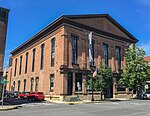Henry A. and Evanlina Dubois House
Columbia County, New York Registered Historic Place stubsGreek Revival houses in New York (state)Houses completed in 1840Houses in Columbia County, New YorkHouses on the National Register of Historic Places in New York (state) ... and 1 more
National Register of Historic Places in Columbia County, New York

Henry A. Dubois and Evanlina House is a historic home located at Hudson in Columbia County, New York. It was built about 1840 and is a 2+1⁄2-story, wood-frame dwelling with a stone-and-brick foundation and hipped roof in the Greek Revival style. The front facade features a one-story, three-bay open central porch with four Ionic order columns and a deep entablature. A Victorian wood cupola was added to the roof about 1870. Also on the property is an L-shaped wood-frame barn dated to the 1860s.It was added to the National Register of Historic Places in 2004.
Excerpt from the Wikipedia article Henry A. and Evanlina Dubois House (License: CC BY-SA 3.0, Authors, Images).Henry A. and Evanlina Dubois House
Worth Avenue, Town of Greenport
Geographical coordinates (GPS) Address Nearby Places Show on map
Geographical coordinates (GPS)
| Latitude | Longitude |
|---|---|
| N 42.239722222222 ° | E -73.781388888889 ° |
Address
Worth Avenue 4414
12534 Town of Greenport
New York, United States
Open on Google Maps








